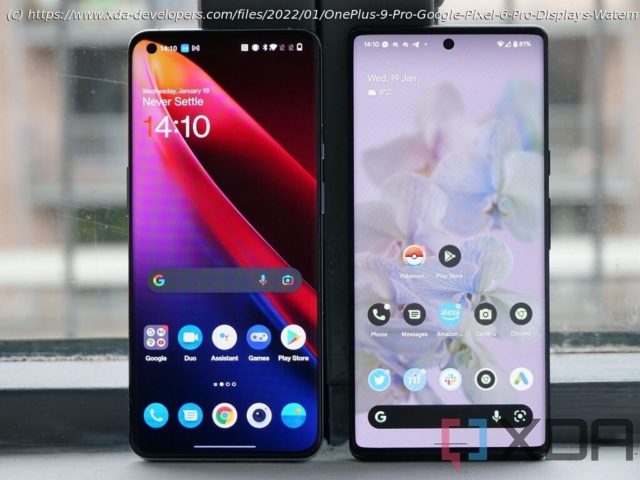The Google Pixel 6 Pro and the OnePlus 9 Pro are two flagship smartphones with very different aims. How do they compare? Check it out!
We’ve entered 2022, but the next round of flagships are still a few weeks away. Even then, there’s value to be seen from devices launched in 2021, especially when those devices are flagships such as the Google Pixel 6 Pro and the OnePlus 9 Pro. While the OnePlus 9 Pro has undoubtedly been marred in controversy ever since its Android 12 update, it’s still a good device with a lot to give. The Google Pixel 6 Pro, meanwhile, has also had its own fair share of problems, failing particularly when it comes to software stability. Things are improving, but it’s certainly taking a while. With the OnePlus 9 Pro, you can avoid a lot of the problems that it has by upgrading to Android 12 and factory resetting if you end up having any. However, the company has pushed a new update which means you mightn’t even need to do that. Meanwhile, the Google Pixel 6 Pro is a little bit outdated when it comes to security patches, as a combination of the holiday period, bugs, and the latest quarterly feature drop has resulted in what appears to be a difficult time for the developer team. If you’re in the market for a new phone, though, and you want it to be one of these, which should you go for? In this deep dive, we analyze the real differences between both the Google Pixel 6 Pro, the OnePlus 9 Pro, and find out which is better for you. About this review: This comparison was written after testing a Google Pixel 6 Pro sent to me by Google Ireland and a OnePlus 9 Pro sent to me by OnePlus U.K. Neither company had any input in this article. The Google Pixel 6 Pro and the OnePlus 9 Pro are both extremely different phones in their designs. While OnePlus has slowly moved towards a more “mainstream” design in recent years, the same certainly cannot be said for Google. The Google Pixel 6 Pro has a more playful design coming in at 6.7-inches, with a camera bar on the back that sticks out. The OnePlus 9 Pro, on the other hand, is a more familiar design, with a camera module on the top left of the back of the device. Both phones have curved glass at the sides and curved glass on the back. Both phones feel similar in hand, and both attract fingerprints pretty easily on the back — the OnePlus 9 Pro especially so. As for the display, both devices feature 1440p 120Hz displays, though the OnePlus 9 Pro’s display is a bit taller and slimmer than the Pixel’s. The OnePlus 9 Pro display corners are also much more rounded, while the Google Pixel 6 Pro’s corners are more subtle. The OnePlus 9 Pro panel also gets a lot brighter, though, in their quality, both are more than good enough for pretty much any content consumption. To be honest, the main difference comes down to either display brightness or the punch hole. Display brightness typically matters a whole lot more in real-world usage, especially during the summer. As for the front-facing camera location, the punch hole on the OnePlus 9 Pro is on the left, whereas on the Pixel, it’s in the middle of the notification bar. At that point, it’s just personal preference as to which you prefer! The camera design is where both of these devices really differ, and the Google Pixel 6 Pro’s camera bar has a few advantages. Its biggest advantage is its uniformity across the back means that the device doesn’t rock a table, while also retaining a unique look that can’t be found on any other device. If the camera bump bothers you that badly, any of the best Google Pixel 6 Pro cases will do away with it. In the case of the OnePlus 9 Pro though, it’s rather basic and doesn’t really offer anything original. It pokes out a small bit, which can be rectified with either the included case or any other of the best cases for the OnePlus 9 Pro. As for camera specifications, OnePlus partnered with Hasselblad for its color science on the OnePlus 9 Pro, and it’s capable of some pretty nice shots. It’s the best camera in a OnePlus smartphone for sure, especially as the company’s smartphone cameras were, at best, considered mediocre prior. Eventually, the partnership is expected to evolve into custom hardware including custom lenses. We’re not at the point yet where OnePlus is using custom Hasselblad lenses, but the OnePlus 9 Pro does feature a new color solution applied to all image sensors called Natural Color Calibration with Hasselblad and a Hasselblad Pro Camera mode. In addition, this OnePlus smartphone debuted Sony’s IMX789 image sensor for the main camera. It’s a 48MP image sensor with Sony’s 2×2 on-chip lens solution, supports 12-bit raw capture, and is paired with an optical image stabilizer module to stabilize user-induced motion. The secondary camera features Sony’s IMX766 image sensor that’s also found in both cameras on the OPPO Find X3 Pro, which we praised for producing superb wide-angle shots. The IMX766 is paired with a freeform lens for distortion-free ultra-wide-angle photos and macro photography as close as 4cm from the subject. Finally, there’s also an 8MP telephoto camera for 3.3x optical zoom, stabilized by OIS. When it comes to the Google Pixel 6 Pro though, it’s an entirely different beast. Pixel smartphones are known for their cameras, and the Pixel 6 Pro is no different. It features a 50MP Samsung GN1 camera and a 12MP Sony IMX 386 ultra-wide lens, along with an additional 48MP Sony IMX 586 for 4x optical zoom. The IMX 386 is a very old sensor and suffers from noise particularly in low-light conditions. Google Tensor is the company’s first custom mobile chipset, and it’s made specifically for the Google Pixel 6 Pro.






